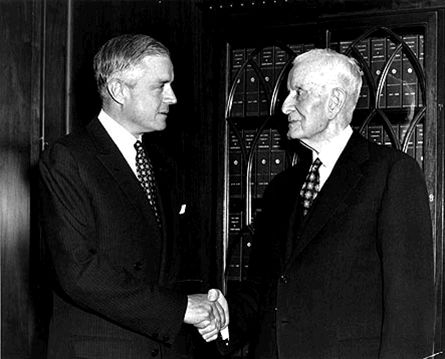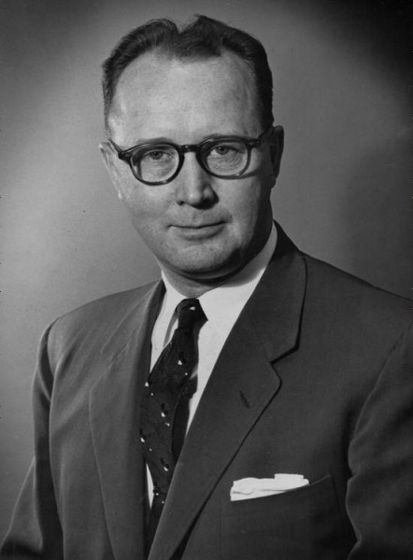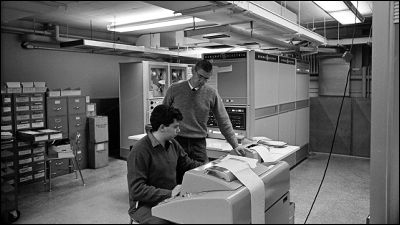The world's first magnetic disk storage device (hard disk) Story till "RAMAC" is born in IBM

Although the mainstay of the device (storage) to store data is shifting from the magnetic disk type HDD to the SSD using the flash memory, the magnetic disk type storage device has been in storage for more than half a century since the second world war He has been active in the front line of the device. A story about how a magnetic disk storage device that played an important role to support the substantial evolution of computers was born from IBMEngineering and Technology History Wiki (ETHW)It is revealed in.
Creating Magnetic Disk Storage at IBM - ETHW
http://ethw.org/Creating_Magnetic_Disk_Storage_at_IBM
When World War II ended in 1945, it became an urgent task for IBM to switch from a business model that depended on military industry to IBM. Thomas Watson Sr., IBM's president at that time, let him see the Moore school of the University of Pennsylvania to bring back his son Watson Jr. from the army to IBM. So, later onENIAC"Watson Jr., who saw a huge computer that needed enough room to fill the entire room, would have known that ENIAC had 18,000 vacuum tubes and burned vacuum tubes daily It seems that I felt that "This is not for sale" as I look at the situation that I have no choice but to replace it.
Watson Jr., who returned from a visit by the University of Pennsylvania, will be revealed about a top secret project on computers developed by my father and run by a few weeks later. later"IBM 603Although this computer, which will be announced as "computer", started development before the Second World War, the prospect of commercialization was not established. However, Watson Jr., who was impressed by the deki, strongly appealed to my father, "Even if only a few can be produced, it should be published with the" world's first commercial electronic calculator "by touching, We accepted Watson Jr.'s return to IBM by placing Watson Jr. as the responsible person, "Well, you do it."

And in the year 1947 when Watson Jr. returned to IBM IBM 603 was announced and two years later it evolved to a faster and versatile "IBM 604".

In 1951 the US National Tax Research Bureau intends to introduce a presumption computer for the presidential electionUNIVACWhen it contracts with IBM, the positions as IBM's leading experts in the field of electronic calculation and data processing are greatly shaken. UNIVAC was common as a recording device at the timePunch cardI replaced it with a metal magnetic tape, but the advantage of the magnetic tape over the punch card is clear, and it seems that the IBM company has experienced a tremendous shock, saying that all IBM punch card devices will be replaced.Eckert-Mauchly Computer CorporationYaEngineering Research AssociatesBy changing to a magnetic tape type, Watson / Jr. reaffirms the end of the punch card and strongly feels the necessity of developing a new device to change this.

Watson Junior persuaded the president Watson Senior to make the number of employees in the research department less than 1000 at that time back to 4000 or more by 1955. However, at that time, excellent engineers and researchers were on the West Coast of the United States a lot, they were reluctant to move to New York on the east coast where IBM is headquartered and struggled to acquire excellent engineers. Therefore, Watson Jr. opened a laboratory in San Jose, California to acquire engineers on the west coast. In 1934, Watson and Senior delegated Reynolds Johnson to the top.

The building of the San Jose Institute of IBM has a five-year lease contract, Johnson limits it to a technician with an electronics background, provides better conditions than any company's research and development department, actively I issued a job advertisement. As a result, Suzuki succeeded in acquiring Lewis Stevens with experience as a naval radar engineer. It seems that the number of engineers who were 30 people in the summer has doubled to 60 people at the end of the year. After establishing the IBM San Jose Institute, it was said that the major task for several months was to decide an excellent research project for new employees.

When Johnson is appointed as the development manager of the storage device which turns into the punch card, with reference to the open development environment adopted by Ralph Palmer of IBM Poughkeepsie Institute, maintenance of the environment where engineers can discuss and help each other without a barrier Started. Each engineer is required to help other researchers beyond the work assigned, and it seems that "to help other laboratory engineers" was listed as the top priority. This policy not only creates a collaborative research environment but each researcher can receive stimulation from others, resulting in rapid technical development.
Arthur Clichy Row, who joined IBM in 1952, shows a serious problem that while punch cards perform very high performance when processing data sequentially by batch processing, the speed is extremely slow at random data access I was looking at what I was holding a problem. IBM researchers are consensus about the superiority of the magnetic disk method to increase the random access performance, but familiar with the difficulty of developing unprecedented products in the computer industry IBM The engineers said that they were struggling to develop.
Meanwhile, IBM's researchers also began full-scale development of magnetic disk storage devices when Jakob Rabinow published the first research on magnetic disk storage devices in computer journals in August 1952. In January 1953, Jeffrey Hossam designed a disk with improved magnetic disks of Ravinov and submitted it to Klitschlow. I proposed as a device to replace the punch card.

In a well-developed development environment created by Johnson, Hossam's magnetic disk storage mechanism quickly spread throughout the IBM San Jose Institute, and Hossum's plan succeeded in installing a lot of support. At the same time potential issues and solutions were actively discussed. And despite being in a state where problem solving was not completely done, Johnson declined to abandon the choice of any other storage, and decided to unify the development target into a magnetic disk type. At this time, the IBM San Jose Institute at that time had an objection that "the fact that that rivalry company has not developed that method is a reason to explain the size of the problem", but Johnson He said he made a decision.
After that, Johnson, who took part in IBM's business meeting in Los Angeles in April 1953, explained the necessity and urgency of developing magnetic disk storage devices to sales and new product personnel, Persuade. When returning to the IBM San Jose Institute for the go-ahead of developing magnetic disks, it seems that he got a big welcome from the laboratory engineer.
When magnetic disk development began, Johnson appointed William Goddard to the development manager and named Hossum on his right arm. Although the aluminum plate was adopted as the magnetic disk, since it caused too much blurring at the beginning of development, we devised a method to anneal the thickness and the metal surface.

In addition, the problem of scattering of particles of iron oxide applied to the disk by rotation occurred, improvements in coating technology were repeated. In the face of the greatest problem of keeping the distance between the rotating magnetic disk and the magnetic head for reading and writing data constant,Air bearingsClear this by.

The magnetic disk storage device "RAMAC"Is a huge device with 50 aluminum disks 24 inches in diameter and 0.1 inch thick with a storage capacity of 5 million characters (5 MB), a magnetic disk rotation speed of 1200 rotations per minute, tracks to be read and written The time required for the head to move to the sector was 0.8 seconds at maximum.

In January 1955 Stevens reported that RAMAC prototype worked correctly with Johnson of IBM San Jose Institute top. The management team of the IBM who received the news soon recognized the importance of the RAMAC project and instructed the production of 14 RAMAC machines for IBM internal customers and special customers. And sample shipment was finally done in June 1956 in order to obtain feedback for improving RAMAC, the world's first commercial HDD was born here.
Watson Jr., who took over from IBM's CEO from my father in May 1956, officially announced the world's first HDD as "IBM 305 RAMAC" in September 1956. IBM 305 in the system processing part was rented for 3,200 dollars per month (about 1.15 million yen at the time) and the storage part "IBM 350" for 650 dollars a month (about 230 thousand yen at that time). RAMAC became popular as a peripheral device of IBM computer "IBM 650" at that time, and that combination was said to be called "IBM 650 RAMAC".

In 1957, purchased IBM 305 was released instead of lease, and more than 1000 IBM 305 were manufactured by the end of sales in 1961.

Although IBM has produced a magnetic disk type storage device that can pass through for more than 50 years in the field of computer technology where extraordinary technological innovations occur one after another, IBM sold HDD drive division to Hitachi in 2002 to manufacture HDD I am retiring from.
Related Posts:
in Hardware, Posted by darkhorse_log







